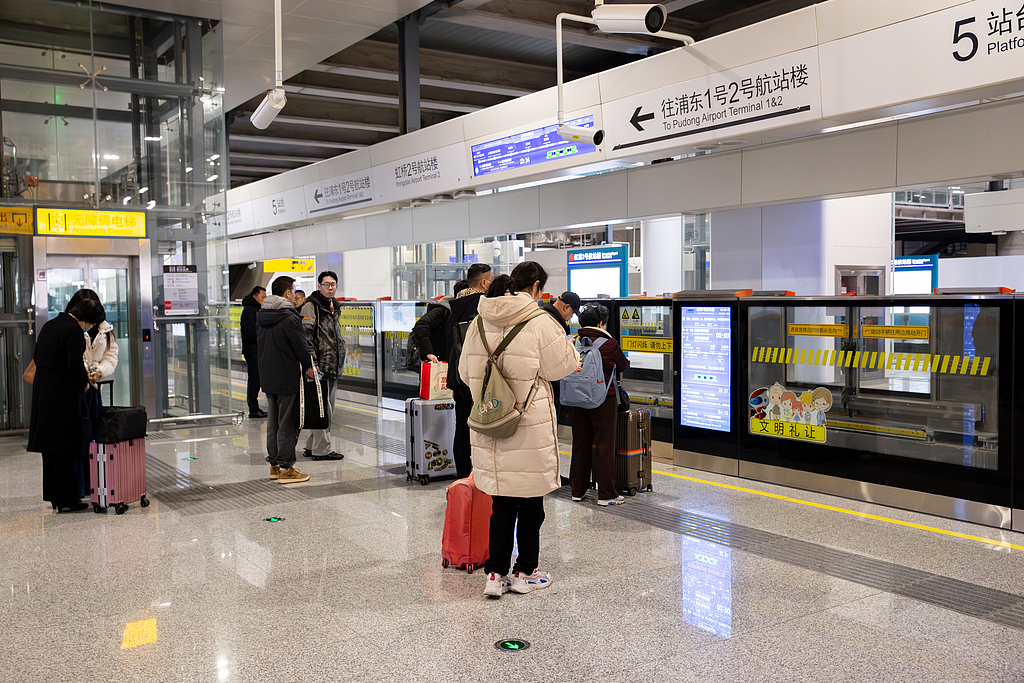 Passengers wait on the platform at Hongqiao Airport Terminal 2 station of a rail line linking the two major airports in Shanghai on Dec 27. The Shanghai Suburban Railway Airport Link Line commenced operations on the day. [Photo/CFP]
Passengers wait on the platform at Hongqiao Airport Terminal 2 station of a rail line linking the two major airports in Shanghai on Dec 27. The Shanghai Suburban Railway Airport Link Line commenced operations on the day. [Photo/CFP]
Shanghai unveiled a high-speed rail link between its two major airports on Dec 27, reducing transit time between the city’s aviation hubs to just 40 minutes.
The Shanghai Suburban Railway Airport Link Line had its inaugural ceremony at Shanghai Hongqiao International Airport, where Gong Zheng, mayor of Shanghai, announced the official launch of the line.
Prior to the airport link’s launch, transiting between Hongqiao and Shanghai Pudong International Airport via the metro took around 1 hour and 40 minutes. The new high-speed airport rail cuts that transit time to just 40 minutes.
For the initial operating phase, the 59-kilometer line, constructed by State builders including China Railway 24th Bureau Group Corp, features trains capable of 160 km/h. It has seven stations passing through three districts, intersecting four existing metro lines.
Service runs from 6 am to 10:39 pm daily, with trains departing both airport terminals every 15 minutes, according to Shanghai Metro.
“I’m looking forward to taking the new line,” said Alessandro Conti, an Italian doing business in Shanghai who welcomed the upgraded airport transit option.
On its first day, the airport rail link had already carried nearly 7,000 passengers as of 11 am, according to local media eastday.com.
Designated one of 11 pilot metropolitan rail corridors nationally, the airport link is Shanghai’s first independently invested, constructed and operated metropolitan line adhering to mainline railway specifications.
With its launch, Shanghai’s total operational rail transit network now spans 896 kilometers across 21 lines and 517 stations, including this new seven-station airport corridor.
“This airport connector serves three key functions,” said Chen Xiaohong, a transportation professor at Tongji University. “It links Pudong International Airport more conveniently to the broader Yangtze Delta region, ties together Shanghai’s two major aviation hubs allowing better coordination, and provides new accessibility for the city’s southern districts.”
Chen emphasized the project’s highest contribution is integrating Pudong — which handles the majority of China’s international air travel — into the national high-speed rail network spanning the economically vital Yangtze Delta region.
“Pudong is our nation’s most vital international aviation gateway,” noted Chen. “However, its location on Shanghai’s far eastern area created challenges in efficient regional rail integration, which this connector has resolved.”
The new airport link’s debut comes amid booming international travel demands thanks to China’s widely welcomed 240-hour transit visa-free policy. As of Wednesday, Shanghai’s Pudong airport immigration checkpoints had already processed over 30 million entry and exit travelers this year — a 78 percent increase over last year’s total and marking 22 consecutive years as China’s busiest.
Over 7.6 million foreign nationals passed through Pudong’s immigration facility this year, up 110 percent year-on-year. This included 1.22 million visitors entering visa-free under the policy, accounting for 30 percent of international arrivals.
“This airport line is the most important and significant improvement in convenience for international passengers,” Chen added.
,https://english.shanghai.gov.cn/en-Latest-WhatsNew/20241230/c2e1f804b3294e588fcb4b4d413be7e0.html
